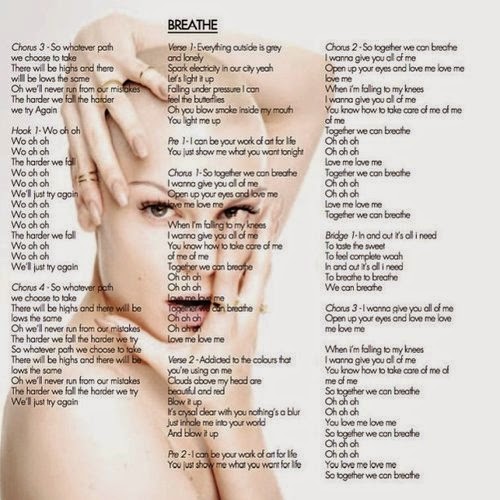Everything about this album is designed to draw
attention from a specific auidence.
Front cover:
The front cover has a
prominent image of Rihanna; she is positioned in the centre of the cover and
against a white background, this is done so that she is the main point of focus
and so attention isn't diverted from her.
Rihanna is pictured naked but
writing is used to cover up most of her body, this is done to make the cover
less explicit. But it also creates emphasis; the words that are used to cover
her body are representative of her; words such as 'victory', 'love' and 'faith'
these are all aspirational words that she aims to achieve. Furthermore, the
name of the record label that she is signed to 'Roc Nation', is written on her
chest where her heart would be. This shows that it is a part of her life that
she love. Rihanna also manages to incorporate her fans into the album cover by
including '#Navy', this is the name given to her fan base. This creates a
deeper connection between her and her fans, and makes the feel appreciated. It
is also a clever way to incorporate social media; anyone who didn't already
know about her fan base, after one look of the album they would. Essentially,
this album cover is Rihanna declaring her love and her appreciation for the
things she cares about; the things that define her.
The album title
'Unapologetic' is very significant for Rihanna. She went from being a modest
pop artist to suddenly becoming the 'bad girl', who flaunts her body and
promotes herself and her music through her sex appeal and raunchy behaviour. And
this album is her saying she isn't sorry for being the way she is. And this
message is amplified by the nude image of her on the album cover; she's going
to pose naked is she wants and there is nothing anyone can say that can stop
her.
The text is in white; this is
done to create a contrast against her rich skin colour. The text is written in
different fonts and in different sizes. For example the word 'Love' is written
in a font that's very fluid and delicate as it resembles someone's handwriting,
this is done to echo the idea that love is delicate; it could also connote the
idea of a 'love letter'. The only but of black writing is found on her right
arm and it says 'Side effects'; a connotation if this is, the side effect of
being a famous musician is that you change. This could symbolise that she is
unsure of the person she is. Furthermore, the fact that Rihanna's name isn't visible on the front cover suggests that this is not her first album; she is so iconic and so recognisable she doesn't need to follow the typical conventions of an album e.g. having a close up of the star on the front cover.
Back cover:
There is another prominent image on Rihanna on the back
cover; she is nude but wearing an oversized leather studded jacket, this is done to reinforce her 'bad girl' image. The colours used on the back cover are very monotonous; they consist of blacks, whites and greys. In terms of colour is it a very simplistic; this shows that she is moving away from the 'bubblegum pop' image that we know her for and she's now maturing and finding who she is as an artist; she has reinvented her entire star image through this one album. Institutional information such as Rihanna's record label is visible on the back cover; this allows the audience to identify the genre of Rihanna's music if they don't already know.











































